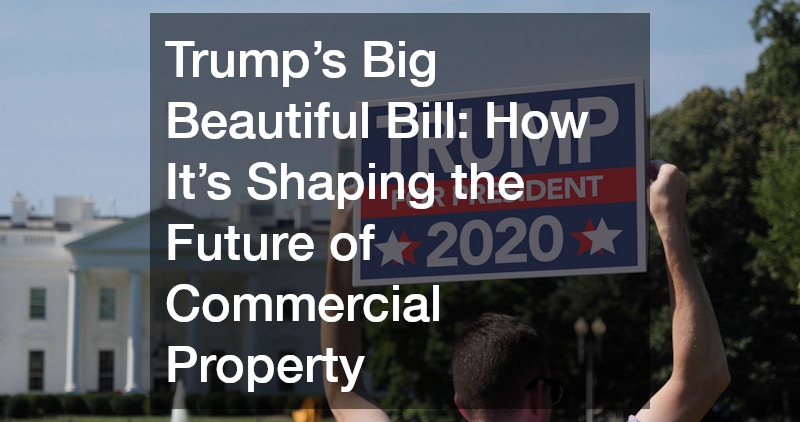
President Donald Trump has never been shy about bold statements, and his “Big Beautiful Bill” was no exception. While the phrase initially grabbed headlines for its rhetoric, the lasting implications of the legislation tied to it are being felt in sectors like commercial property. Designed to reshape regulations and promote economic growth, this policy initiative has played a significant role in the evolution of how commercial spaces are developed, owned, and operated across the United States.
At its core, the bill aimed to reduce federal red tape, incentivize investment, and repatriate business activity to American soil. These goals—when filtered through the lens of commercial property—translated into both direct and indirect changes that have redefined the landscape for investors, developers, and tenants alike.
Deregulation and Development Opportunities
One of the most notable impacts of Trump’s bill was the sweeping deregulation efforts it supported. By reducing restrictions on land use and construction permits, developers found it easier to break ground on new projects.
The relaxation of environmental review timelines and streamlined zoning approvals created a friendlier climate for large-scale developments, particularly in suburban and industrial zones.
This change has led to a surge in new commercial property builds, from distribution centers to mixed-use office spaces. Developers, no longer bogged down by years-long approval processes, could act on market demand more efficiently. In turn, this has increased the pace at which businesses can expand their physical presence, especially in high-growth regions.
Tax Incentives That Fueled Investment
The bill also included provisions that heavily incentivized investment in certain regions of the country through the creation of Opportunity Zones. These zones were designated areas in need of economic revitalization, and investors who directed capital into commercial property within these zones were eligible for favorable tax treatment.
This approach not only drew in significant private investment but also sparked a wave of redevelopment in underserved areas. Vacant buildings were transformed into thriving hubs of activity, and new construction brought jobs, services, and innovation to regions that had long been overlooked. For the commercial real estate sector, these zones became hotspots for growth and speculation.
A Shift Toward Domestic Industry
Another key pillar of Trump’s legislative push was the emphasis on domestic manufacturing and supply chain realignment. As tariffs and international policy changes made offshore operations more complex, many businesses turned their focus back to American soil. This pivot brought a fresh wave of demand for commercial property suited for industrial use—warehouses, logistics hubs, and manufacturing facilities.
The result has been a resurgence in industrial development across the Midwest and Southern states. Properties once considered obsolete have been repurposed for modern logistics and production needs, while entirely new facilities have risen to meet the demand for domestic infrastructure.
Influence on Tenant Preferences
With increased investment and a shifting economic focus, tenant expectations for commercial property have also evolved. Businesses are now looking for spaces that not only meet traditional needs but also support operational resilience. Flexibility, modern amenities, and enhanced digital infrastructure are now top priorities for companies navigating the post-2020 landscape.
This shift has compelled developers and property managers to adapt quickly, incorporating smart technologies, green building materials, and modular design principles into their offerings. The drive toward innovation in property design and functionality can be traced in part to the larger economic conditions catalyzed by Trump’s bill.
Policy Ripple Effects
Beyond the bill’s direct legal language, its tone and positioning sent strong signals to the business world. The message was clear: business growth, property development, and domestic investment were national priorities. This sentiment shaped how financial institutions approached lending for commercial property projects and how municipalities positioned themselves to attract developers.
Moreover, the bill’s emphasis on economic zones and infrastructure investment opened the door for public-private partnerships, leading to creative approaches in financing and planning. Commercial developers began working more closely with local governments, aligning projects with regional growth strategies to secure support and resources.
Long-Term Impact and the Road Ahead
Though Trump’s presidency has concluded, many of the changes his bill introduced continue to influence commercial property trends. The groundwork laid during his administration has reshaped how developers approach projects, how investors allocate resources, and how businesses select their physical locations.
As new administrations put forth their own priorities, some elements of the bill may be revised or repealed. However, the broader impact on the commercial property sector—accelerated development, increased domestic investment, and a renewed focus on strategic zoning—will likely remain embedded in the market for years to come.
Trump’s “Big Beautiful Bill” was more than just a catchy phrase; it catalyzed real and lasting change in the American commercial property landscape. By reducing barriers, incentivizing growth, and reshaping the national conversation around development, the bill helped reenergize one of the country’s most important economic engines. As commercial property continues to evolve, the echoes of that legislation will still be heard in the deals, designs, and decisions shaping America’s built environment.



